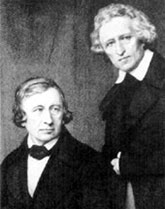Jacob and Wilhelm Grimm
Critique

Born
Jacob 1785, Wilhelm 1786
Died
Jacob 1863, Wilhelm 1859
Publications
Story collections, linguistics
Writing language
German
Literature
• Grimm's Fairy Tales (1939)
Story Collections
• Grimm's Fairy Tales (1939)
German Literature
• Grimm's Fairy Tales (1939)
Fantasy Literature
• Grimm's Fairy Tales (1939)
The serious business of telling fairy tales
They never created a story in their lives, yet their tales may be the best-known in the western world. Everyone over the age of four knows the adventures of Cinderella, Little Red Riding Hood, Hansel and Gretel, Snow White and countless other characters in German folklore. We cannot imagine our culture without references to them. Yet we would not have this legacy without the work of the Brothers Grimm in collecting and publishing these stories.
You see, we call these "fairy tales" and tend to think of them as kids' stuff, like nursery rhymes or Disney cartoons. But Jacob (he's the slightly older one on the right in the picture) and Wilhelm Grimm were quite serious in their work.
They saw it as preserving in print the stories that had been passed along orally from generation to generation. Their volumes of Kinder- und Hausmärchen (translated literally as Children's and Household Tales, but usually referred to as Grimm's Fairy Tales) were fit into lifetimes of research in the fields of linguistics, mythology and history.
Diverse stories
Born in Hanau, Germany, Jacob and Wilhelm were the eldest brothers in a family of seven children (three others dying in infancy) and spent their lives working, studying and publishing together. They both studied law at the University of Marbourg and, started gathering folk-tales in 1806. Their first compilation of fifty-three tales was never published but they continued their collecting, taking work as librarians in Kassel.
In 1812 the first volume of eighty-six stories was published, and in 1815 the second volume added seventy more. In 1822 the third volume of fairy tales appeared.
Throughout these years they also published diverse works on linguistics, folklore, epic poetry and medieval life. Most notably, in 1816 and 1818 they produced two volumes of Deutsche Sagen, a collection of 585 German legends.
In 1826 the brothers produced Irische Elfenmärchen (Irish Fairy Tales), a translation and commentary on Thomas Crofton Croker's Fairy Legends and Traditions of the South of Ireland.
They also produced studies individually over the years, the most significant being Jacob's Deutsche Grammatik (Germanic Grammar), which was recognized as the greatest philological work of its age. It introduced what is still know as "Grimm's Law" which shows how the sounds of consonants shift between languages—for example, the "p" in the Latin pater becoming the "f" sound in the English father and the German vater.
Meanwhile the the three-volume fairy-tale compilation went through continual corrections and rewriting, until by its seventh edition in 1857 it would end up with two hundred stories, plus ten "Children's Legends". The seventh is the edition usually considered authoritative and is the basis for most translations into other languages, including English.
The brothers had given up their positions as librarians in Kassel and had become professors at the University of Göttingen in 1829. But a few years later they were fired with five other professors for joining a protest against the rescinding of a liberal constitution. They eventually took new academic appointments at the more liberal University of Berlin.
In 1884 and 1852, Jacob and Wilhelm retired in order to devote their remaining years to their research. At the time of their deaths, four years apart, they were working on their historical and etymological German dictionary, Deutsches Wörterbuch. Having started at A in this enormous work, they had got partway through F, leaving generations of scholars to work on it for another century before the thirty-two volumes were completed. Not quite a fairy-tale ending, but a monumental contribution nonetheless.
— Eric
Critique

